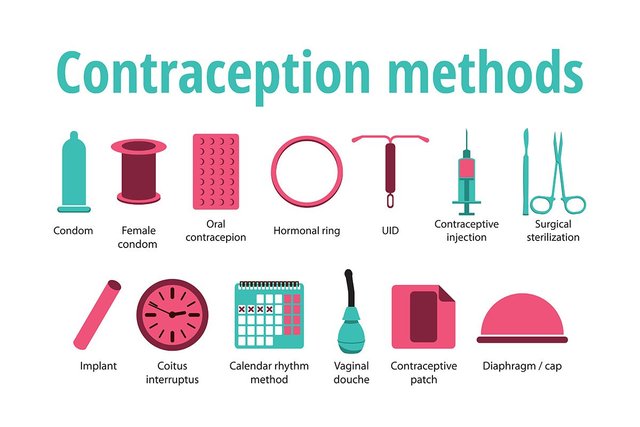Can You Get Pregnant When Having Sex Through Clothes?
In order to get pregnant, you need to have sexual intercourse between a male and a female and this means genital penetration. Although it is possible for contact between the genital areas (without penetration or intercourse) to lead to pregnancy, this is unusual. By using birth control correctly, you can greatly reduce your risks of getting pregnant from sexual intercourse. Despite this, it is important to remember that there is no birth control method that is 100% accurate. Today, let's discuss the case of having sex through clothes.

Can You Get Pregnant Through Clothes?
Some couples simply don’t want to have complete sexual intercourse. The reasons can vary from not having a condom handy to wanting to wait a bit longer. In this case, things may advance faster than you think and ejaculation outside the vagina can occur. When this happens, many couples worry about whether it is possible to get pregnant if one or both of you are still wearing clothes.
The good news is that you don’t usually have to worry about getting pregnant in this case. The chances of a sperm getting through the clothing, into the vagina, to the cervix, through the uterus, into the Fallopian tubes and finding an egg are incredibly small.
This is not a culprit of unintended pregnancies. It is important to remember that getting pregnant through clothes is completely different than withdrawal. Withdrawal would be when the man takes his penis out of the woman’s vagina immediately before ejaculating. This isn’t effective (only about 70% effective), because pre-ejaculate contains sperm and can still end up inside the vagina.
Can I Get Pregnant in These Situations?
1. Can I Get Pregnant with My Underwear on?
You will not get pregnant with your underwear on. Although it is possible to get pregnant if you are making out naked, even this risk is extremely low. For you to conceive, the female genital area needs to come in contact with sperm and this is extremely unlikely without penetration. Despite this, it is theoretically possible to get pregnant if sperm come in contact with your genitals (but not through clothing).
2. Can I Get Pregnant Without Penetration?
Theoretically, you can get pregnant without penetration if your genitals come in contact with sperm. Despite this, there is only a small risk of unwanted pregnancy from this. The bigger concern would be getting an STI or HIV.
3. Can I Get Pregnant If Sperm Gets on My Privates?
It is theoretically possible for you to get pregnant if sperm gets on your privates, but it is incredibly unlikely for this to happen.
4. Can I Get Pregnant During My Period?
It is possible to get pregnant during your period, but it is very unlikely, because most women won’t ovulate while they have their period. Despite this, eggs can live 2 days while sperm live 5 to 7 within your body. It is possible for these two to find each other during your period. Keep in mind that menstrual blood may transmit HIV, so safe sex is especially crucial at the time of the month.
5. Can I Get Pregnant from Oral Sex?
No, it is impossible to get pregnant from receiving or giving oral sex.
6. Can I Get Pregnant in a Pool or Hot Tub?
No, sperm is not capable of traveling through water such as in a hot tub or pool and therefore you can’t get pregnant when you are in these situations.
What Can I Do to Prevent a Pregnancy after Having Sex?
If you have already have sex, your only option to avoid pregnancy after sex is to use the morning after pill which is referred to as emergency contraception. You have to take it within 72 hours of sexual intercourse and you can get either by a prescription or directly from your doctor or health clinic.
When you take the morning after pill, you will notice that it involves two doses. Inside the pill are the same hormones from birth control pills but in higher concentrations. You take the two doses 12 hours apart, preferably as soon as possible. Although the morning after pill can stop a pregnancy, it isn’t 100% effective (no birth control method is except abstinence) and therefore it shouldn’t be your main form of birth control.
Learn the Common Birth Control Methods to Have Safe Sex
Every method of birth control works slightly differently, but they tend to fall into categories. Keep in mind that no method other than abstinence will be 100% effective, but the risk of getting pregnant with most methods is extremely small. The following are the methods of birth control, organized by type.

1. Abstinence
This means never having any type of sex and this is the only way to prevent STIs such as HIV as well as to prevent pregnancy.
2. Rhythm Method
The rhythm method is also known as natural family planning and is when you either abstain from sex or use a barrier strategy when you are most fertile. To follow this method, you need to determine when you are ovulating.
3. Barrier Method
This method involves placing some:
- Contraceptive Sponge. It is a soft device shaped like a disc that contains spermicide. You wet it and put it inside your vagina before having sex. You must leave it in for between six and thirty hours to be effective.
- Diaphragm. A diaphragm is similar to a cervical shield or cervical cap. Each of these will block sperm, so they cannot enter your cervix where they would reach the egg. You add spermicide to the devices before using them and then leave them in for 6–8 hours to 24 (diaphragm)–48 (cap and shield) hours.
- Female Condom. It is worn inside the vagina and shouldn’t be used together with a male condom. It is only good for one use.
- Male Condom. It is placed over the penis and is made of natural/lambskin material, polyurethane, or latex. They can be lubricated or non-lubricated.
4. Hormonal Method
The hormones interfere with fertilization, ovulation, or the implantation of a fertilized egg. Methods include:
- Oral Contraceptives. Oral contraceptives are usually referred to as the pill and there are multiple options available. Your doctor can help you choose the right one.
- The Patch. You wear a patch for three weeks of every four and it prevents your ovaries from releasing eggs.
- Injection/Shot. You get an injection every three months, but you shouldn’t use it for over 2 consecutive years.
- Vaginal Ring. You insert this inside your vagina and wear it for three weeks of every four.
5. Implantable Method
Inserting a device in your body and leaving it for several years. These include:
- Implantable Rod. It goes in the upper arm.
- IUDs (Intrauterine Devices). They can either be copper IUDs which release copper or hormonal which release hormones.
6. Permanent Method
These methods can’t be reversed and include:
- Sterilization Implant. It involves inserting a device in the fallopian tubes and growing scar tissue.
- Surgical Sterilization. The fallopian tubes can be sealed, tied or cut. In men, a vasectomy stops sperm from traveling to the penis.
7. Emergency Method
Emergency contraception is frequently known as the morning after pill or plan B. It can have one or two doses and is used after sexual intercourse in case of emergencies.